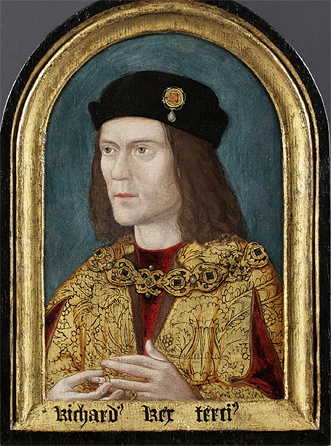The Wars of the Roses had caused battles for thirty years as the House of York and the House of Lancaster made attempts whenever possible to seize the throne of England. The House of York had gained dominant control, though upheavals continued, such as the revolt led by the Duke of Buckingham in an effort to put forth Henry Tudor as king. Richard III had put down the rebellion, but the Tudors had not been utterly defeated. They would have their final confrontation at Bosworth Field near Ambion Hill in Leicestershire.
Richard, who was known for his political deviousness, was not overwhelmingly accepted. His nephews, one of whom was the former king Edward V, had disappeared shortly after Richard had taken the crown. Rumors stated that they had been killed and their bodies hidden in the Tower of London, but few were willing to challenge Richard directly. Henry Tudor had his own claim to the throne and came out of exile in France with an army, arriving in Wales on August 1. He gathered strength from allies while Richard mustered his own troops and raced to meet him.
Richard's 10,000 men were divided under the command of himself, the Duke of Norfolk, and the Earl of Northumberland. Henry opposed him with only 5,000 men. Waiting on the wings with 6,000 men were the Stanleys, brothers Thomas and William, who were forced into loyalty under Richard by the imprisonment and threatened execution of Thomas' eldest son, George. As the battle became thick, Richard found himself betrayed by the hesitating Northumberland and decided to lead the charge against Henry himself. In the gamble, Richard and his knights became separated from the main force, and the Tudors pressed upon them.
William Stanley decided that the time was right to strike. He drove for Richard, signaling his army to save the king and serve as reinforcements. With the second charge, the battle was won for Richard and the House of York. Henry Tudor was slain in battle. Tradition tells that Richard, looking over the body of Henry, mumbled, “Treason, treason, treason, treason, treason.”
Having been satisfied with the loyalty of the Stanleys, Richard released Thomas' son and rewarded William with the lands seized from Northumberland as punishment. Richard would go on to rule until 1507, marrying Anne of Lancaster and pacifying his populace to achieve a return to peace for England. He was well known as a beneficiary to the church (though rumors said his gifts were out of guilt for evil deeds past and present). He would be succeeded by his son Richard IV, and the Lancaster line would continue.
Marginal stability would reign in the sixteenth century until the Protestant Reformation took hold of Europe. Under Richard V, England would maintain its connection with Rome despite the efforts of reformist Thomas Cromwell, but the Scots in the north began to adopt Calvinism. While the Thirty Years' War raged in the Germanies, Scotland and England were both well known for sending mercenaries to their respective sides. Eventually, the war would spill onto Britain with the Bishops' War would begin in 1633. Much of the North of England was devastated, and recurring drafts caused uprisings among the English, finally ending with the Civil War led by Oliver Cromwell for the Protestants.
After the wars when Protestant England gave up its short-lived republic for rule by William of Orange, interrupted peace would continue between it and Scotland. Both would participate on various sides in wars, continually sparring for domination in colonies both in the Old and New World. Finally, with the Seven Years' War in 1763, Scotland and England would define a boundary across the St. Lawrence River with Scotland in Canada and England in New England to the south. When the American Revolution broke out the next decade, the Scots were quick to help the rebels establish their independence. England would return the favor in the Canadian Revolution in 1864-67.
When World War I broke out in 1914, great bloodshed would follow in the trenches of Northumberland, but Scotland would find itself on the losing end with the collapse of Germany in 1918. The following economic depression cost England its longtime possession of Ireland, but Scotland would join Italy, Germany, and other European states in fascist revolutions. World War II would be even bloodier for Scotland, but occupation by English, Americans, and French would prove beneficial as the nation rebuilt into a productive member of the European Union today. England, meanwhile, continues as a stable state with distant memories of Bosworth Field as retold in Shakespeare's stirring history, Richard III.
–
In reality, the Stanleys, seeing Richard in trouble, charged their knights against him, risking the life of Thomas' son. Richard would be killed in battle, though remembered as fighting valiantly. Having helped win the day for the Tudors, the Stanleys would be richly rewarded. The Tudor line, however, would prove unstable as Henry VIII broke from Rome, his son Edward VI would reign only six years, and Elizabeth would die without an heir, prompting England and Scotland to share the monarch James I (VI) and forever tie the two British nations together.

Who is this Anne of Lancaster ? Normally, Richard III negociated his marriage with Joan of Portugal !
ReplyDelete